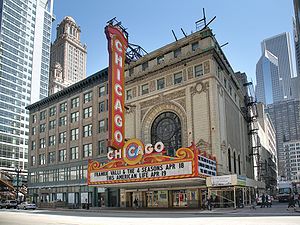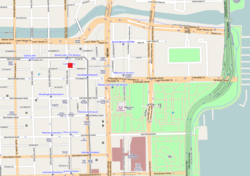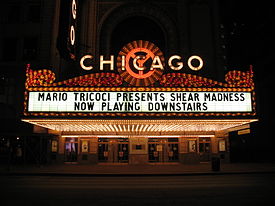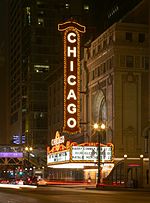- Chicago Theatre
-
This article is about the landmark theater. For the theater movement, see Theatre in Chicago.Balaban and Katz Chicago TheatreChicago Landmark
 Chicago Theater's Facade, State Street
Chicago Theater's Facade, State StreetLocation: Chicago, Illinois Coordinates: 41°53′7″N 87°37′40″W / 41.88528°N 87.62778°WCoordinates: 41°53′7″N 87°37′40″W / 41.88528°N 87.62778°W Built: 1921 Architect: Rapp & Rapp Architectural style: Neo-Baroque/Neoclassical (exterior);[2][3] French Baroque (Neo-Baroque)(interior)[2] NRHP Reference#: 79000822[1] Significant dates Added to NRHP: June 6, 1979 Designated CL: January 28, 1983 The Chicago Theatre, originally known as the Balaban and Katz Chicago Theatre, is a landmark theater located on North State Street in the Loop area of Chicago, Illinois. Built in 1921, the Chicago Theatre was the flagship for the Balaban and Katz (B&K) group of theaters run by A. J. Balaban, his brother Barney Balaban and their partner Sam Katz.[4] Along with the other B&K theaters, from 1925 to 1945 the Chicago Theatre was a dominant movie theater enterprise.[5] Now the Chicago Theatre is a performing arts venue for stage plays, magic shows, comedy, speeches, and popular music concerts. It is owned by Madison Square Garden, Inc.
The building was added to the National Register of Historic Places on June 6, 1979,[6] and it was listed as a Chicago Landmark on January 28, 1983.[7] The iconic Chicago Theatre marquee, "as an unofficial emblem of the city", appears in film, television, artwork, and photography.[7]
Contents
History
Grand opening, growth, and decline
Abe and Barney Balaban, together with Sam and Morris Katz (founders of the Balaban and Katz theater chain), built the Chicago Theatre in 1921 with plans for it to be one of a large chain of opulent motion picture houses.[5] The theater would become the flagship for 28 theaters in the city and over 100 others in the Midwestern United States that B&K operated in conjunction with the Paramount Publix chain.[8] The building was constructed at a cost of 4 million dollars and was designed by architects Cornelius W. Rapp and George L. Rapp. The Rapp brothers also designed many other B&K properties in Chicago, including the Oriental and Uptown Theatres.[9] The Chicago Theatre was one of the first theaters in the nation to be built in Rapp and Rapp's signature Neo-Baroque French-revival style.[2] It is the oldest surviving example of this style in Chicago.[7][10]
When it opened on October 26, 1921, the 3,880 seat theater was promoted as the "Wonder Theatre of the World".[9][10] Capacity crowds packed the theater during its opening week. The feature film was First National Pictures' The Sign on the Door starring Norma Talmadge, and other attractions included a 50-piece orchestra, famed organist Jesse Crawford at the 29-rank Wurlitzer organ, and a live stage show.[11] Poet Carl Sandburg, reporting for the Chicago Tribune, wrote that mounted police were required for crowd control.[9] The theater's strategy of enticing movie patrons with a plush environment and top notch service (including the pioneering use of air conditioning) was emulated nationwide.[5]
During its first 40 years of operation, the Chicago Theatre presented premiere films and live entertainment. Throughout its existence, many of the top performers and stars of their day made live appearances at the theater. One of its biggest draws was live jazz, which Balaban and Katz promoted as early as September 1922 in a special event they called "Syncopation Week". This proved so successful that jazz bands became a mainstay of the Chicago Theatre's programming through the 1920s and into the 1930s.[9] In preparation for the 1933 World's Fair in Chicago, the Chicago Theatre was redecorated. The building has been associated with popular culture occasions. For example, Ronald Reagan announced his engagement to Jane Wyman at the theater.[12] It was also modernized in the 1950s when stage shows were discontinued.[9]
A slow down in business at the Chicago Theatre, caused by economic and social changes during the 1970s, whilst it was owned by Plitt Theatres, affected ongoing viability. In 1984, the Chicago Theatre Preservation Group purchased the theater and adjoining Page Brothers Building for $11.5 million ($24.3 million today).[13] Attempts at using the structure as a picture theater failed to maintain that viability and the building was closed on September 19, 1985.[11]
Restoration
The Y-shaped figure behind the horizontal word Chicago on the State Street marquee is the city's municipal badge, which symbolizes the forked Chicago River at Wolf Point.[14][15]
The Chicago Theatre Preservation Group commenced renovation of the buildings and both were completed in 1986 at a cost of $9 million ($18 million), which includes $4.3 million ($8.6 million) spent on the Theatre.[13] During the renovation, the Chicago Theatre was restored to a 1930s appearance by architects Daniel P. Coffey & Associates, Ltd and interior design consultants A.T. Heinsbergen & Co. The Chicago Theatre reopened on September 10, 1986 with a performance by Frank Sinatra.[10] This reopening marked the culmination of a four-year historic preservation effort championed by the Landmarks Preservation Council of Illinois,[13][16] which has left the current seating capacity of the theater at 3,600.[11] The gala reopening was also symbolic because Sinatra had performed at the theater in the 1950s.[12] The restoration of the adjoining Page Building, which is itself a Chicago Landmark and on the National Register of Historic Places,[17] provided office space to support the Chicago Theatre.[18] The theater, like its neighbor (the Joffrey Tower), is an important component of the North Loop/Theatre District revitalization plan.[13] Theatre district revitalization plans go back as far as Mayor Jane Byrne's 1981 plan.[12]
Revitalized
On April 1, 2004 the building was purchased by TheatreDreams Chicago, LLC for $3 million.[19][20] The Balaban and Katz trademark is now the property of the Balaban and Katz Historical Foundation. On October 11, 2007 it was announced that New York's Madison Square Garden Entertainment, subsidiary of Cablevision, was buying the theater.[21]
Prior to 2008, the theater had hosted the annual opening-night film of the Chicago International Film Festival until the festivities moved to the nearby Harris Theater.[22] Mayor Richard M. Daley declared July 12, 2005 "Roger Ebert Day in Chicago" and dedicated a plaque under the marquee in his honor. The theater is featured in a new book, The Chicago Movie Palaces of Balaban and Katz, by David Balaban, grandson of the original owner.[23]
Architecture
The structure is seven stories tall and fills nearly one half of a city block. The 60-foot (18 m) wide by six-story tall arch on the State Street façade is designed similarly to the l'Arc de Triomphe in Paris.[12] The coat of arms of the Balaban and Katz chain—two horses holding ribbons of 35 mm film in their mouths outlined by a border of film reels—is set inside a circular Tiffany stained glass window inside the arch.[3][11] The exterior of the building is covered in off-white terra cotta supplied by the Northwestern Terra Cotta Company with Neo-Baroque plaster designs by the McNulty Brothers.[2]
The interior shows French Baroque influence from the Second French Empire.[2] The grand lobby, five stories high and surrounded by gallery promenades at the mezzanine and balcony levels, is influence by the Royal Chapel at Versailles. The grand staircase is patterned from one inside the Paris Opera House and ascends to the various balcony levels.[11] Marshall Field and Company supplied interior decorations including drapes and furniture. The crystal chandeliers and bronze light fixtures fitted with Steuben glass shades were designed and built by Victor Pearlman and Co.
The stage dimensions exceed 60 feet (18 m) in width and 30 feet (9.1 m) in depth. The orchestra pit is approximately 6 feet (1.8 m) below stage level, 54 feet (16 m) wide at the stage lip, with a depth of 15 feet (4.6 m) at center. An adjustable pit filler can be used for performances requiring other levels.[24]
The entire marquee was replaced in 1994, but retains the look of its predecessor, which was not part of the original design.[2] In 2004, the original marquee was donated to the Smithsonian Institution.[13] The marquee is featured in numerous movies and TV shows set in Chicago, and its neon font was used in the title of the 2002 film Chicago.
Notes
- ^ "National Register of Historical Places - Illinois (IL), Cook County". National Register of Historic Places. National Park Service. 2007-05-01. http://www.nationalregisterofhistoricplaces.com/IL/Cook/state.html. Retrieved 2009-08-10.
- ^ a b c d e f Schulze, Franz and Kevin Harrington, Chicago's Famous Buildings, "Chicago Theatre", pg. 58-9, 2003, University of Chicago Press, ISBN 0-226-74066-8.
- ^ a b Steiner, Frances, The Architecture of Chicago's Loop p. 27., 1998, Sigma Press, ISBN 0-9667259-0-5.
- ^ "Chicago Theatre: home of WurliTzer (opus 434 )". Chicago Area Theatre Organ Enthusiasts. http://www.catoe.org/chicago.html. Retrieved 2008-09-25.
- ^ a b c Klingsporn, Geoffrey. "Balabian & Katz". Encyclopedia of Chicago. http://www.encyclopedia.chicagohistory.org/pages/103.html. Retrieved 2007-04-19.
- ^ [http://www.nr.nps.gov/iwisapi/explorer.dll?IWS_SCHEMA=NRIS1&IWS_LOGIN=1&IWS_REPORT=100000044 http://www.nr.nps.gov/iwisapi/explorer.dll?IWS_SCHEMA=NRIS1&IWS_LOGIN=1&IWS_REPORT=100000044[dead link] "Index][dead link] by State and Name (Links)"]. National Park Service. Archived from [the original on March 5, 2007. http://web.archive.org/web/20070305064042/http://www.nr.nps.gov/iwisapi/explorer.dll?IWS_SCHEMA=NRIS1&IWS_LOGIN=1&IWS_REPORT=100000044[dead link]. Retrieved March 3, 2007.[dead link]
- ^ a b c "Chicago Theatre". City of Chicago Department of Planning and Development, Landmarks Division.. 2003. http://www.ci.chi.il.us/Landmarks/C/ChicagoTheater.html. Retrieved March 2, 2007.[dead link]
- ^ Gomery, Douglas (May 1992). Shared pleasures: a history of movie presentation in the United States. University of Wisconsin Press. pp. 57. ISBN 978-0299132149. http://books.google.co.uk/books?id=YyFQNU_F5DMC&pg=PA57&lpg=PA57&dq=Paramount+Publix+katz&source=bl&ots=0fhAviJViA&sig=R2pe1Mgmo2JVUSunJCDQ5rcPuKI&hl=en&ei=mEmLSsjdI6fbjQetsN1e&sa=X&oi=book_result&ct=result&resnum=1#v=onepage&q=Paramount%20Publix%20katz&f=false. Retrieved 2009-08-19.
- ^ a b c d e Scott Newman. "Jazz Age Chicago:Chicago Theatre". http://chicago.urban-history.org.+Archived+from the original on 2008-01-22. http://web.archive.org/web/20080122095912/http://chicago.urban-history.org/sites/theaters/chicago.htm. Retrieved March 3, 2007.
- ^ a b c "Historic Theatres & Movie Palaces of Balaban and Katz: The Chicago Theatre — A Brief History". Uptown Chicago Resources (online). Compass Rose Cultural Crossroads, Inc.. 2007. http://www.compassrose.org/balaban-and-katz/Chicago-Theatre.html. Retrieved 2007-05-01.
- ^ a b c d e "The Legendary Chicago Theatre: About the Chicago Theatre". http://www.thechicagotheatre.com/about/history.html. Retrieved March 2, 2007.
- ^ a b c d "Dispute Over Theatre Splits Chicago City Council". New York Times. May 8, 1984. http://www.nytimes.com/1984/05/08/us/dispute-over-theater-splits-chicago-city-council.html?sec=travel. Retrieved 2007-03-02.
- ^ a b c d e "1986: The Chicago Theater Reopens". Chicago Public Library. February 2006. Archived from the original on 2008-02-12. http://web.archive.org/web/20080212003717/http://www.chipublib.org/004chicago/timeline/chitheater.html. Retrieved 2007-05-07.
- ^ "The Municipal Device". Forgotten Chicago. http://forgottenchicago.com/features/chicago-signs/the-municipal-device/. Retrieved 2010-11-21.
- ^ "The Chicago Municipal Device (Y-Shaped Figure)". Chicago Public Library. Archived from the original on 2006-09-03. http://web.archive.org/web/20060903132608/http://cpl.lib.uic.edu/004chicago/chiy.html. Retrieved 2007-06-20.
- ^ Granacki, Victoria (2006). "About Us: Landmarks Preservation Council of Illinois". Landmarks Illinois. http://www.landmarks.org/about_us.htm. Retrieved 2007-05-04.
- ^ "Page Brothers Building". City of Chicago Department of Planning and Development, Landmarks Division. 2003. http://www.ci.chi.il.us/Landmarks/P/PageBrothers.html. Retrieved 2007-05-01.[dead link]
- ^ Sinkevitch, Alice (.ed), AIA Guide to Chicago, pg. 53, 2004, Harcourt Books, ISBN 0-15-602908-1.
- ^ "Theatre Dreams". Archived from the original on 2007-12-30. http://web.archive.org/web/20071230110849/http://www.thechicagotheatre.com/about_theatre_dreams.htm. Retrieved March 2, 2007.
- ^ Patner, Andrew (2004-03-28). "Restoration drama: TheatreDreams determined to revive Chicago stage". Chicago Sun-Times. http://docs.newsbank.com/openurl?ctx_ver=z39.88-2004&rft_id=info:sid/iw.newsbank.com:NewsBank:CSTB&rft_val_format=info:ofi/fmt:kev:mtx:ctx&rft_dat=101C41452C2B90BC&svc_dat=InfoWeb:aggregated5&req_dat=AA98CDC331574F0ABEAFF732B33DC0B2. Retrieved 2009-08-11.
- ^ Jones, Chris. "Chicago Theatre to be sold to major New York producer" - Theatre Loop - Chicago Tribune - October 9, 2007
- ^ Caro, Mark (2008-10-17). "Fest 'Blooms' with Chicago connections". Chicago Tribune. http://docs.newsbank.com/openurl?ctx_ver=z39.88-2004&rft_id=info:sid/iw.newsbank.com:NewsBank:CTRB&rft_val_format=info:ofi/fmt:kev:mtx:ctx&rft_dat=123E1B86395EE3C0&svc_dat=InfoWeb:aggregated5&req_dat=AA98CDC331574F0ABEAFF732B33DC0B2. Retrieved 2009-08-12.
- ^ "Balaban and Katz Historical Foundation". Balaban and Katz Historical Foundation. http://www.balabanandkatzfoundation.com. Retrieved 15 August 2009.
- ^ "The Chicago Theatre: Venue Technical Packet 2006" (PDF). Archived from the original on 2007-12-02. http://web.archive.org/web/20071202132808/http://www.thechicagotheatre.com/documents/ChicagoTheaterTechPack_000.pdf. Retrieved 2007-05-01.
External links
- The Chicago Theatre
- Historic Images of the Chicago Theatre
- History of the Chicago Theatre
- Balaban and Katz Foundation
- Balaban and Katz
U.S. National Register of Historic Places Topics Lists by states Alabama • Alaska • Arizona • Arkansas • California • Colorado • Connecticut • Delaware • Florida • Georgia • Hawaii • Idaho • Illinois • Indiana • Iowa • Kansas • Kentucky • Louisiana • Maine • Maryland • Massachusetts • Michigan • Minnesota • Mississippi • Missouri • Montana • Nebraska • Nevada • New Hampshire • New Jersey • New Mexico • New York • North Carolina • North Dakota • Ohio • Oklahoma • Oregon • Pennsylvania • Rhode Island • South Carolina • South Dakota • Tennessee • Texas • Utah • Vermont • Virginia • Washington • West Virginia • Wisconsin • WyomingLists by territories Lists by associated states Other  Category:National Register of Historic Places •
Category:National Register of Historic Places •  Portal:National Register of Historic Places
Portal:National Register of Historic PlacesCity of Chicago Chicago metropolitan area · State of Illinois · United States of America Architecture · Beaches · Climate · Colleges and Universities · Community areas · Culture · Demographics · Economy · Flag · Freeways · Geography · Government · History · Landmarks · Literature · Media · Music · Neighborhoods · Parks · Public schools · Skyscrapers · Sports · Theatre · Transportation
 Category ·
Category ·  Portal
PortalChicago Loop Theater District Cadillac Palace Theatre · Chicago Theatre · Goodman Theatre · Harris Theater · Jay Pritzker Pavilion · Joffrey Tower · Bank of America Theatre · Oriental Theatre
South Loop Theatres
Auditorium Theatre · Merle Reskin Theatre · Petrillo Music ShellChicago Landmark cultural venues National Historic Landmark,
National Register of Historic Places,
Chicago LandmarkNational Historic Landmark,
National Register of Historic PlacesNational Register of Historic Places,
Chicago LandmarkBiograph Theater · Chicago Cultural Center · Chicago Theatre · Fine Arts Building · Former Chicago Historical Society Building · Uptown TheatreChicago Landmark Civic Opera Building · Congress Theater · Field Museum of Natural History · Harris and Selwyn Theaters · Museum of Science and Industry · Navy Pier Headhouse and Auditorium · New Regal Theater · Pui Tak Center · South Side Community Art Center · Sunset Cafe · Thalia Hall · Yondorf Block and HallApartments · Culture · Education · Historic Districts · Houses · Memorials and Monuments · Municipal · Skyscrapers · Transportation · Worship Categories:- NRHP articles with dead external links
- Buildings and structures completed in 1921
- Cinemas and movie theaters in Illinois
- Concert halls in the United States
- Landmarks in Chicago, Illinois
- Music venues in Chicago, Illinois
- National Register of Historic Places in Chicago, Illinois
- Theatres in Chicago, Illinois
- Movie palaces
- Visitor attractions in Chicago, Illinois
Wikimedia Foundation. 2010.





